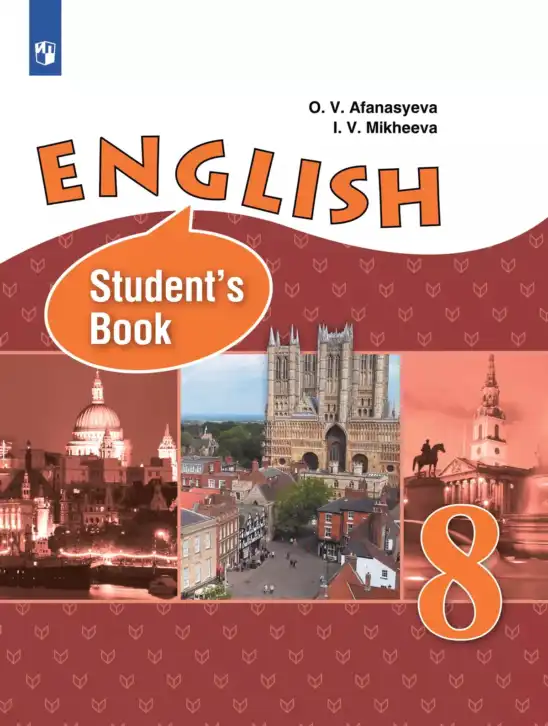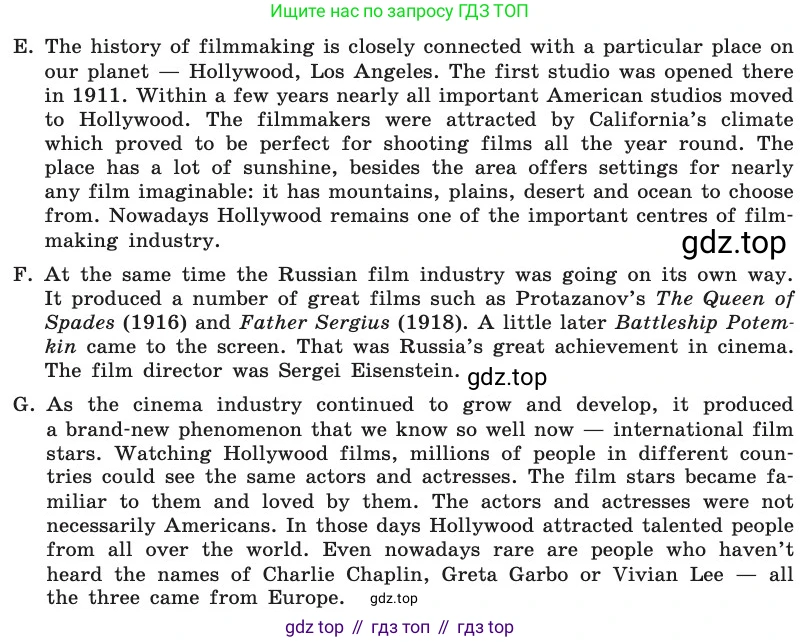Номер 3, страница 289 - гдз по английскому языку 8 класс учебник Афанасьева, Михеева

Авторы: Афанасьева О. В., Михеева И. В.
Тип: Учебник
Издательство: Просвещение
Год издания: 2014 - 2025
Уровень обучения: углублённый
Цвет обложки: белый
ISBN: 978-5-09-034201-8
Допущено Министерством просвещения Российской Федерации
Популярные ГДЗ в 8 классе
Unit 6. Newspapers and Television: The World of Mass Media. Get Ready For Your State Final Assessment. Unit Six. Newspapers and Television: The World of Mass Media - номер 3, страница 289.
№3 (с. 289)
Условие. №3 (с. 289)
скриншот условия



3 Read the text and match its paragraphs (A-G) with the titles (1-8). You don’t have to use one of the titles.
1. New Place with Perfect Opportunities | 4. Films That Learned to Talk |
2. Pastime Very Little Money Could Buy | 5. Story Line as a New Achievement |
3. Recognized Everywhere | 6. Scenes of Common Life |
7. New Tricks of Make Believe | |
8. Not Like Films in the West |
A. You can easily imagine what shock people had back in 1895 when they saw the first films in history. The earliest filmmakers were the French Lumiere brothers. And the earliest films were very short — they lasted from 60 to 90 seconds and didn’t tell a story. They were just glimpses of reality: a running horse, a boxing match, the ocean and so on. You probably know that one of the first films showed a train coming towards the camera. When the audience saw it, they panicked and ran away. They were sure that the train was coming right into the room where they were sitting. The first films were black-and-white and had no sound. They were shown in cafes, theatres and shops. People who called themselves “projectionists” brought the early films to small places all over the country.
B. Very soon filmmaking became an international phenomenon and a new form of entertainment. The films themselves were changing too. Now they were longer and, very importantly, started to tell stories. The first western in the history of cinema lasted 11 minutes and became a sensational hit in 1903. It was called The Great Train Robbery and told a simple story of bandits holding up a train. Since that time the western has become one of the most popular types of films, especially loved by teenagers. Storytelling films made the cinema one of favourite pastimes in many places and particularly in the USA.
C. In the United States they began to build the so-called “nickelodeons” where people paid a nickel (five cents) to watch several “shorts” (short films). It was much cheaper than going to the theatre or buying a music hall ticket and most of people could easily afford this new form of entertainment. Film shows were accompanied by pianists or even orchestras. At about the same time printed titles were invented. They gave dialogue, descriptions and commentary. As a result, the stories told by films became more intricate and intriguing.
D. Early films became even more attractive for the public when filmmakers learned how to use special effects. For example, while making the film The Execution of Mary, Queen of Scots the director Alfred Clark stopped the camera and replaced the actress with a doll. Georges Méliès, a French film-maker, is remembered for his interesting experiments with special effects. This man, who originally was a professional magician, produced, directed and appeared in more than 500 films. A lot of modern special effects can be traced to his work.
E. The history of filmmaking is closely connected with a particular place on our planet — Hollywood, Los Angeles. The first studio was opened there in 1911. Within a few years nearly all important American studios moved to Hollywood. The filmmakers were attracted by California’s climate which proved to be perfect for shooting films all the year round. The place has a lot of sunshine, besides the area offers settings for nearly any film imaginable: it has mountains, plains, desert and ocean to choose from. Nowadays Hollywood remains one of the important centres of filmmaking industry.
F. At the same time the Russian film industry was going on its own way. It produced a number of great films such as Protazanov’s The Queen of Spades (1916) and Father Sergius (1918). A little later Battleship Potemkin came to the screen. That was Russia’s great achievement in cinema. The film director was Sergei Eisenstein.
G. As the cinema industry continued to grow and develop, it produced a brand-new phenomenon that we know so well now — international film stars. Watching Hollywood films, millions of people in different countries could see the same actors and actresses. The film stars became famous and loved by them. The actors and actresses were not necessarily Americans. In those days Hollywood attracted talented people from all over the world. Even nowadays rare are people who haven’t heard the names of Charlie Chaplin, Greta Garbo or Vivian Lee — all the three came from Europe.
Решение. №3 (с. 289)

Решение 2. №3 (с. 289)
Прочитайте текст и соотнесите его абзацы (A-G) с заголовками (1-8). Один из заголовков использовать не нужно.
Ответ:
A - 6. Scenes of Common Life (Сцены из обычной жизни)
B - 5. Story Line as a New Achievement (Сюжетная линия как новое достижение)
C - 2. Pastime Very Little Money Could Buy (Развлечение, которое можно было купить за очень небольшие деньги)
D - 7. New Tricks of Make Believe (Новые трюки для создания иллюзии)
E - 1. New Place with Perfect Opportunities (Новое место с идеальными возможностями)
F - 8. Not Like Films in the West (Не такие, как фильмы на Западе)
G - 3. Recognized Everywhere (Узнаваемы повсюду)
Другие задания:
Помогло решение? Оставьте отзыв в комментариях ниже.
Присоединяйтесь к Телеграм-группе @top_gdz
ПрисоединитьсяМы подготовили для вас ответ c подробным объяснением домашего задания по английскому языку за 8 класс, для упражнения номер 3 расположенного на странице 289 к учебнику 2014 года издания для учащихся школ и гимназий.
Теперь на нашем сайте ГДЗ.ТОП вы всегда легко и бесплатно найдёте условие с правильным ответом на вопрос «Как решить ДЗ» и «Как сделать» задание по английскому языку к упражнению №3 (с. 289), авторов: Афанасьева (Ольга Васильевна), Михеева (Ирина Владимировна), углублённый уровень обучения учебного пособия издательства Просвещение.
















